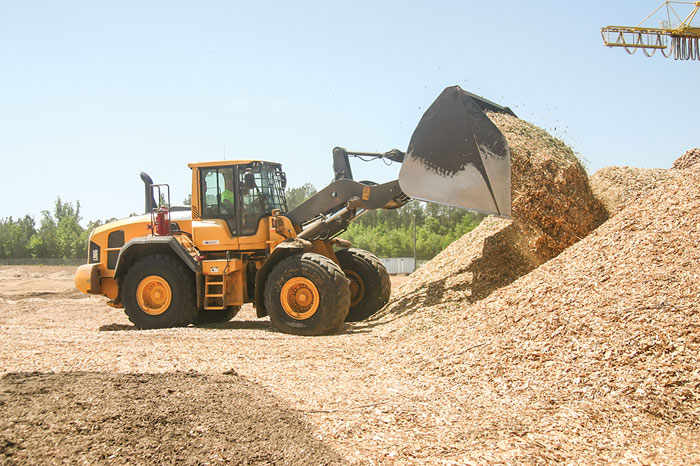Enviva Pellets Northampton is well into full production mode at its 500,000 metric tons production capacity wood pellet plant here, and has even produced in excess of its “nameplate” capacity.
Enviva purchased the 121 acre plant site in August 2011, received its first logs in November 2012, produced its first chip in February 2013 and produced its first pellet in April 2013.
The Northampton plant is the second of three wood pellet plant startups that occurred in less than two years in the region for Enviva. The company started up its plant at Ahoskie, NC (365,000 metric tons) in November 2011, and its Southampton, Va. facility (500,000 metric tons) in September 2013. In 2011 it also acquired and expanded a deep water port terminal at the Port of Chesapeake with two-dome storage of 90,000 metric tons. Not to be forgotten are the pellet plants in Amory and Wiggins, Miss. the company purchased in 2010 and expanded to 105,000 and 110,000 metric tons, respectively. Add a contract operation with a third party in Bayou, La. at 50,000 metric tons, and Enviva today offers approximately 1.6 million metric tons of U.S. production capacity. Production from the Southeastern plants is shipped from the Port of Mobile through a partnership arrangement.
And it’s no secret that Enviva is interested in possibly building new production capacity (see interview with CEO John Keppler, page 18).
One reason Enviva chose to locate its three newest plants in the mid-Atlantic was to benefit from the robust wood basket and raw materials supply infrastructure that was already in place. The region’s privately owned commercial forests demonstrate growth in excess of harvest, and Enviva provides an outlet for low grade fiber and residuals.
The mid-Atlantic operations primarily use hardwood, though softwood is also part of the furnish. Raw materials include low grade whole trees, tops and limbs, in-woods chips and sawmill residuals such as shavings and sawdust.
The company is implementing a proprietary track and trace system to provide data on the key attributes of the forest tracts, including everything from Best Management Practices to conservation value.
“Sustainability is fundamental to our business,” states Enviva’s Director of Marketing and Communications, Elizabeth Woodworth, adding that it holds certifications from leading sustainable forestry organizations such as the Sustainable Forestry Initiative, Forest Stewardship Council and Programme for the Endorsement of Forest Certifications.

The quick progression of the three facilities has provided a classic opportunity of applying lessons learned along the way. The intention for the Ahoskie plant was to develop it into the company’s reference case for industrial scale pellet production. Subsequently, Northampton was the first facility developed under Enviva’s “build and copy” approach. For example, the Northampton and Southampton process islands are replicas of the same equipment, process flow and operating profile of the Ahoskie facility with minor modifications for site conditions and layout.
Enviva’s senior team of engineers and construction executives has designed, built and commissioned each of their facilities and port terminals. “Given our build and replicate approach, we have been able to standardize the major installed equipment for each of our key process islands; and as we subcontract the major construction trades (i.e. civil, mechanical, electrical) to a common set of providers who typically work with us on each of our facilities in a given region, we are able to improve quality and schedule with each progressive project,” says Norb Hintz, Enviva co-founder and Senior Vice President of Engineering.
The Northampton plant runs seven days a week around-the-clock and has 82 full time hourly employees. The employees were trained in advance of commissioning at the sister mill in Ahoskie. Their maintenance plan is designed in accordance with equipment manufacturers’ specifications and industry best practices. Enviva’s maintenance team at Northampton has 13 members including a planner, storeroom supervisor, plant engineer and a maintenance engineer. Enviva performs both preventative and predictive maintenance (e.g. vibration, oil, and thermographic analysis) on a regular basis.
Enviva implemented aspects of Lean Manufacturing at its Ahoskie plant and continues to do so at Northampton. “Lean methodologies are part of Enviva’s DNA,” says Royal Smith, Vice President of Operations. This culture of continuous improvement embraces the elimination of waste, which leads to enhanced business performance. Also, the Northampton plant has not had a single recordable safety incident in 500+ days (as of July 1) and Enviva has increased its productivity year over year by 24%. Smith adds, “Every day our team members are identifying better ways to run our business. Once these ideas are implemented, we are quickly sharing and adopting these best practices across the company to realize the total potential.”
According to Woodworth, one of the attractions to the Northampton site was the proximity of a strong, experienced workforce. Seventy-five percent of the employees live within 10 miles of the facility or in Northampton County. This ensures that the economic benefits of the operation contribute to the local economy. “Anecdotally, we have seen the Enviva effect in the communities where we operate— in Ahoskie, after Enviva commenced operations, we have seen new stores and businesses come into the downtown area,” Woodworth says.
The employment makeup is a mix of both experienced personnel who spent years in the forest products industry and newly recruited talent. One of the benefits of the “build and copy” approach and the concentration of operations in a particular region means that Enviva can train and share operators, maintenance personnel, spare parts and achieve remarkable economies of scale across its facilities. Most of Northampton’s operators trained at Ahoskie and pulled shifts at that facility before Northampton began commissioning. This familiarity with operations and procedures allowed for dramatic improvements in the production ramp of Northampton over Ahoskie and similarly at Southampton over Northampton.
The Northampton plant manager is Roland Burnett and the fiber procurement manager is Ann Hudomint, both of whom have extensive experience in the wood products industry.